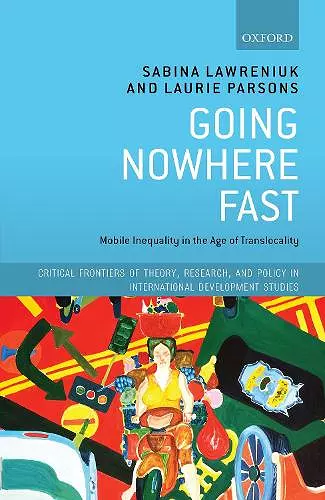Going Nowhere Fast
Mobile Inequality in the Age of Translocality
Laurie Parsons author Sabina Lawreniuk author
Format:Hardback
Publisher:Oxford University Press
Published:27th Aug '20
Currently unavailable, and unfortunately no date known when it will be back

Rising levels of global inequality and migrant flows are both critical global challenges. Set within the Southeast Asian nation of Cambodia, Going Nowhere Fast sets out to answer a question of global importance: how does inequality persist in our increasingly mobile world? Inequality is often referred to as the greatest threat to democracy, society, and economy, and yet opportunity has apparently never been more accessible. Long and short distance transport - from motorbikes to aeroplanes - are available to more people than ever before and telecommunications have transformed our lives, ushering in an era of translocality in which the behaviour of people and communities is influenced from hundreds or even thousands of miles apart. Yet amidst these complex flows of people, ideas, and capital, persistent inequality cuts a jarringly static figure. Going Nowhere Fast brings together a decade of research to examine this uneven development in Cambodia, making a case for inequality as a 'total social fact' rather than an economic phenomenon, in which stories, stigma, obligation and assets combine to lock social structures in place. Going Nowhere Fast: Inequality in the Age of Translocality speaks from an in-depth perspective to an issue of global relevance: how inequality persists in our hypermobile world. Focusing on pressing issues in Cambodia that resonate beyond, it investigates how human movement within and across the nation's borders are intertwined with societal threats and challenges, including of precarious labour and agricultural livelihoods; climate and environmental change; the phenomenon of land grabbing; and the rise of popular nationalism.
I found the book novel not just in terms of the empirical material and the arguments that are developed, but also in terms of the tenor of its argumentation. It is a research monograph but reads, in places, almost like an op-ed piece ... We see here an attempt - largely successful, I should add - to draw the reader into the authors' field sites, the empirical material they generate, and the arguments they explore. They are intent on making these places, conditions and debates accessible and understandable, so that we - the reader - are more likely to care, albeit from a distance. * Jonathan Rigg, ASEAS UK Blog *
How can a development success story like Cambodia be shown to be both less and more than standard economic analyses pronounce? In this compelling book, Parsons and Lawreniuk draw on months of field work to explore the persistence of social immobility against the backdrop of heightened spatial mobility. They show that inequality is not one thing but many, produced through macroforces but experienced in the everyday, at once multiscalar and scaled differentially. More to the point, and unlike Dr Seuss' Little Cat Z, there is no 'Voom' to reach for in the grab bag of policy tricks. * Jonathan Rigg, Chair in Human Geography, University of Bristol *
Going Nowhere Fast by geographers Sabina Lawreniuk and Laurie Parsons is an important contribution to migration and development studies of Cambodia and wider Southeast Asia...This conceptualization distinguishes it from the larger literature on inequality and mobility. As such Going Nowhere Fast deserves a wide readership among scholars of Cambodia and Southeast Asia. * Rosa Yi, Department of Geography, National University of Singapore, Singapore. *
- Winner of Shortlisted for the European Association of Southeast Asian Studies (EuroSEAS) Social Science Book Prize 2021.
ISBN: 9780198859505
Dimensions: 240mm x 163mm x 16mm
Weight: 444g
192 pages